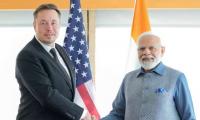Islamabad: South Asia—a region which accounts for over 24% of the world’s population, has the highest prevalence of inequity in the world, and is the least integrated region of the world—finally got some attention at the World Economic Forum’s weeklong annual meeting that commenced in Davos.
The forum, which is framed around managing the Fourth Industrial Revolution or the digital revolution to overcome challenges that have emerged in a “fractured world,” threw the global spotlight on Asia on account of several key considerations.
Dr. Sania Nishtar, the President of Heartfile, spoke in the highest number of sessions, wearing different hats. She spoke in health sessions in her capacity as Chair of the World Economic Forum’s exclusive think-tank—the Council on the Future of Healthcare. She also chaired a meeting in her capacity as Chair of the WHO High Level Non-Communicable Disease Commission. Other than that, she also spoke at two sessions on the future of Asia. She was one of five panelists in a session titled ‘Strategic Outlook: South Asia.’ She was the only Pakistani and the only woman on a panel of five where the other four panelists were all men from India i.e., the editor-in-chief of India Today Group, the chairman of Spice jet, and two prominent businessmen including the youngest Indian billionaire.
Speaking in the session, Dr. Sania reiterated the imperative of regional collaboration and dialogue as an entry point. “The onus of development, trade and cooperation lies on countries themselves, and regional institutions are a very important tool for that. Unfortunately, South Asia does not have the convening institutions to enable our countries to engage,” she stated.
Last year, Dr. Sania extensively campaigned as one of the finalists for WHO’s Director General, and in that role, she had to closely study regional institutions as a prerequisite to seeking support and votes. Dr. Sania stated having found that South Asia is, by far, the least integrated region in comparison to the Caribbean and the Latin Americans, who have moved on towards financial integration, regulatory collaboration, etc.
“Even the smallest and least developed countries of the world are finding common grounds to converge because they realize that it gives them a voice and a seat on the table in the international system. The countries of South Asia stand to gain significantly from pooling resources, specifically in terms of human capital. In today’s digital age, we now know that two-thirds of the wealth of a country is its human capital, and in the years to come, the borrowing ability of countries will be affected by its progress on human development,” Dr. Sania forewarned.
When asked to highlight the way forward, Dr. Sania emphasized the need to have functioning regional institutions that provide a convening space, not just for governments, but also for people, businessmen, and social sector experts, among others. “Alongside that, we need to invest in efforts to have the right evidence to bring to the table.
Participants pose for a group photo ‘Majlis Tehqeeq’ organised a meeting at the Pakistan Academy of Letters on...
A general view of the Chinese embassy in Islamabad. — X/@CathayPak/FileIslamabad: Chinese Embassy here on Wednesday...
Participants attend a national-level mathematics quiz competition ‘Battle of Brains-II’ organized by the...
The logo of the Islamabad Food Authority . — Facebook/Islamabad Food Authority/FileIslamabad:Deputy Director...
This image shows Rawalpindi Police officials interacting with each other on November 30, 2023. — Facebook/Rawalpindi...
Representational image of a spicy dish. — The News/FileIslamabad: In their commitment towards achieving SDG 2 i.e....







